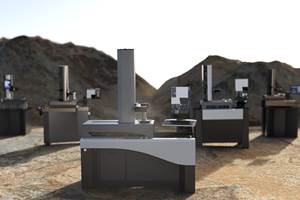Effective Technical Process Through Metrology
As manufacturing processes and the resulting parts become more complex, shops must invest the time and resources to allow their inspection methods to keep pace.
Metrology—the scientific study of measurement—can support an increasingly complex manufacturing world. As metrology experts, we see process-related trends leading to opportunities and challenges ahead.
Planning and Design
New manufacturing techniques are creating more complex parts, and design engineers should keep inspection and measurement duly in mind. Technologies such as additive manufacturing or higher-end five-axis machining can create product designs, shapes or tight tolerance features unlike anything before. But too often new product development is designed without exposure to a corresponding method of measurement. Furthermore, some design engineers have never worked in a hands-on manufacturing environment and don’t have a firm understanding of their facility’s capabilities. Some facilities still depend on old inspection equipment, even for newer tolerances or geometries. Some of this equipment was not even accurate enough for the tolerances when new!
Planning abounds in new product possibilities, especially with metrology included. We see companies justifying the expense of new manufacturing technologies, but overlooking measurement requirements to support the process. This can shortchange inspections, with inefficient quality shortcuts creating process bottlenecks or introducing unnecessary risks when it comes to ensuring parts are made correctly.
Metrology has brought far better gaging to the shop floor, with more production efficiencies and more real-time process control. Almost all gage makers are developing automation integration for their systems. Some high-end automation companies have developed their own interfaces with multiple gage systems to provide a complete part inspection station, either at the machine or as stand-alone automated gaging cells.
When included appropriately in process, metrology becomes a strategic asset—one that fits a more complex environment. We see incredible advancements to support new manufacturing: better gaging on the shop floor, better automation efficiencies, and new 3D scanning techniques such as laser, imaging and CT. Gages today, when designed and used correctly, do a far better job than before. Still, new additive manufacturing and high-precision products create challenges, potentially requiring slow CT scanning systems to determine interior geometries and check for porosity and voids in additive production. High-precision metrology equipment might require that parts go to a proper gage lab and be soaked to temperature before they can be inspected to the tolerances required. Processes must be adapted to this more advanced measurement.
Quality Inspection and Testing
Complex design requirements mean that shops must find and train workers to understand their products’ quality aspects, such as understanding blueprints and geometric dimensioning and tolerancing requirements. Companies can struggle to justify the cost of quality. With more inspections done in-line or near line, the role of quality is spread further through the facility. Instead of a dedicated quality control team of well-trained personnel, more companies rely on machine operators to assume that role—often leading to a problematic lack of focus by untrained operators.
Some companies have turned to outside help for their growing metrology needs. With many dedicated testing facilities, outsourcing often makes financial sense, reducing a shop’s cost of some of the expensive new technologies by purchasing only the inspections it needs. Some companies that are looking to improve quality begin with their own staff on analysis, then follow up with outsourcing to ensure their internal checks are sound.
Importing and Distributing
Here, new activity is evident. Importing machine components creates challenges in approving vendors and ensuring the quality of what is purchased. There’s now a range of metrology methods for measuring and certifying such parts, compounding the approval process when proper metrology techniques were not utilized at both vendor and customer facilities.
The Skills Gap
Finally, advanced planning is a necessity. Two decades of workers fleeing manufacturing has created a five- to 10-year gap in the untrained employment pool. STEM programs are training the next generation, but it will be years before they’re fully in the workforce. Meanwhile, industry must depend on innovative resources for in-house or technical school skill-building. Another possibility is outsourcing, which can free up capital, reduce labor needs and support the quality department. In hiring, employers should look for employees who are trainable, avoiding the assumption that they will come trained. The STEM experience leads to better scientific and technical knowledge and metrology basics (plus adaptability, teamwork, creativity and educational progress). Such an infrastructure eventually will serve today’s more technical manufacturing well.
Aligning measurement, testing and inspection with contemporary manufacturing processes can require investment and foresight. Metrology should not be an afterthought but an integral part throughout the entire process. With industry becoming increasingly high tech, and a lag in a fully prepared technical workforce, metrology specialists can help shops prepare for the future.
About the Author
Thomas Ayers
Thomas Ayers serves as technical director of Metrology for Crotts & Saunders in North Carolina, working with existing and prospective clients to find metrology solutions. With more than 25 years of experience, Mr. Ayers has held positions in design, quality assurance and metrology in both manufacturing and service environments. Contact Crotts & Saunders at crottsandsaunders.com, or 336-765-7250.
Related Content
Does a Scanning Probe Make Sense on a Swiss-Type?
Swiss-types have limited tooling capacity, but there can be advantages to giving up some of that capacity to take advantage of a touch probe — in fact, a scanning probe — to enable in-process part measurements.
Read MoreHow Well do You Know Granite Surface Plates?
Here are some tips for choosing, maintaining and customizing a granite solution that will best meet your shop’s particular inspection needs.
Read MorePMTS 2023 Product Preview: Measurement
Learn about some of the latest measurement solutions that will be on display at PMTS 2023.
Read MoreZoller Event Shines Lights on Shopfloor Connectivity
The company’s open house event highlighted smart manufacturing solutions from CAM to part.
Read MoreRead Next
Metrology Data in the Loop
Where will metrology fit in as the manufacturing industry moves quickly toward an environment that is driven by data and connected across the entire supply chain by a single “digital thread?” A good answer emerged at the recent HxGN Live event, which is the annual international conference sponsored by Hexagon, the global company best known in the manufacturing industry for its broad range of metrology equipment.
Read MoreEmerging Leaders Nominations Now Open
Here’s your chance to highlight a young person in your manufacturing business who is on the path to be a future leader moving your company forward.
Read MoreDo You Have Single Points of Failure?
Plans need to be in place before a catastrophic event occurs.
Read More








.jpg;maxWidth=300;quality=90)













